Varanasi, the world’s oldest city situated on the banks of river Ganga! As soon as the name of Varanasi is mentioned, the sight of a wonderful spiritual city adorned with the enchanting Ganga Ghats and temples appears before the eyes. On one hand, the river Ganga has decorated the entire coast of Varanasi city with many Ghats, on the other hand, it has been decorated with confluences with other rivers on both its ends. At the northern end of Varanasi, Varuna River meets Ganga and at the southern end, Assi River joins Ganga. This city was named Varanasi after these two rivers.
There are many ghats on the crescent-shaped banks of the Ganga between these two holy confluences, from where the city of Varanasi overlooks the river Ganga and innumerable pilgrims get the opportunity to worship Mother Ganga. There are about 84 ghats in Varanasi whose total length is about 6.2 kilometers (about 2 kos). You can trek across all these 84 ghats while going from north to south or from south to north. While visiting all the ghats, you may have to climb up and down the steep stairs of the ghats at some places. The Ganga Ghats of Varanasi are also known for the steepness of their slopes.
Ghats of Varansi (Kashi)
Every Ganga Ghat of Varanasi has its own interesting story. Their names definitely give a glimpse of their relationships and stories, but all of them are surface level facts. Varanasi has been ruled by many rulers. Many saints and sages have also performed penance here. These ghats of Ganga have a deep connection with all of them. Therefore, the names of the ghats are not just names but contain in themselves a storehouse of many deep secrets. Just as the form of any living place keeps changing continuously, similarly the name, shape and form of the ghats of Varanasi have also been continuously changing.
What is Ghat?
Ghats are those beautiful banks of the river where there are some stairs which connect the river to the city. There are so many stairs on the ghat that no matter how much the water level of the river rises and falls due to rain, these stairs take us to the water. The ghats of Varanasi perform the sacred responsibility of taking the devotees to the holy waters of Ganga.
There are ghats built on the banks of almost all the sacred rivers of India through which devotees can easily reach the water of the rivers. Similar beautiful ghats are also built on the banks of river Narmada. An example of this is the beautiful ghats of Maheshwar. Mathura also has beautiful ghats on the banks of Yamuna river.
A specialty of the Ganga in Varanasi is that it flows towards the north here whereas its natural flow is towards the south. There is a popular saying in this regard, ‘Even the Ganga flows in reverse in Kashi’. In Sanskrit it is called Uttaravahini, that is, the one that flows towards the north, as if it is taking one last look at its place of origin, the Himalayas, before merging into the ocean.
The crescent-shaped ghats of Kashi and the many temples located on it appear as if there is a huge crescent-shaped open-air theater surrounding the Ganga. On one side there is water and on the other side there are a large number of temple peaks, ashrams and palaces. There are some stairs between them, connecting the lives on both sides.
Religious and tourist attractions on the ghats of Varanasi
Which devotional and tourism related activities are organized on the ghats of Varanasi? To know this, it is necessary to understand that the Ganga Ghat of Varanasi is actually the center of the cultural and spiritual system of Varanasi. Many religious and tourist attractions are available here.
Boat Ride On Ganga Water
Boat riding on the Ganges waters is an extremely popular activity in Varanasi. I love the time of sunrise for boat ride when the first rays of the sun start falling on the top of the ghats and the many temples located there. On one hand, the first rays of the sun provide a golden glow to the waters of the Ganges, while on the other hand, the sweet sounds of bells and chanting of mantras coming from the temples purify the entire atmosphere. This experience is so unforgettable that getting up early in the morning to experience it does not seem painful at all.
Walking tour on Ganga Ghats
Walking on the ghats is such a wonderful experience as if we are becoming one with Mother Ganga, Kashi and the cosmic energy present here. Experiencing their existence within.
Here you can meet devotees and pilgrims from all over the world. One can discuss with the monks and nuns who come from far and wide and meditate here. Who knows which learned personality you may meet? Coming here has always been a source of new knowledge for me.
Admire The Beautiful Murals
Stories, scenes, caricatures, couplets, quatrains and modern proverbs mentioned in religious texts are painted on the walls of the ghat. These pictures present an interesting blend of spirituality and conservative mentality. Varanasi is a city whose ghats absorb even the opposite mentality with complete ease.
Varanasi Morning Attractions
You can walk on the ghats of Varanasi in the morning, do yoga, meditation etc., take bath, perform yajna rituals and also participate in many cultural events. For this you will have to wake up early in the morning and reach the ghat.
Ganga Aarti
The most popular attraction of the ghats of Varanasi is the Aarti of Ganga Maiya. Earlier this Aarti was performed only at Dashashwamedh Ghat but now Ganga Aarti is performed at many ghats of Varanasi. If we look at Dashashwamedh Ghat, this aarti is performed at many places even at this one ghat.
It is not only a sight to behold but also a wonderful and mesmerizing experience. The only way to know this is to see it and experience it.
Performing worship with the help of priest
Many devotees also come to Kashi so that they can offer prayers and worship to their ancestors at the Ganga Ghat. Worship is also done here to get relief from one’s suffering.
Come, now let me introduce you to some popular ghats of Varanasi.
List of Most Popular Ganga Ghats of Varanasi
Dashashwamedh Ghat
The ghat in the middle of the crescent-shaped beach of Varanasi is named Dashashwamedh Ghat. The main road of Varanasi reaches this ghat. This is the most popular Ganga Ghat of Varanasi.
According to mythology, Lord Brahma performed 10 Ashmedha Yagya for King Divodas of Kashi at this ghat. That is why it was named Dashashwamedh Ghat. There is also a temple named Brahmeshwar here in honor of this event. According to historical sources, horses were traded here in ancient times. It is said that there was also a statue of a horse here which is now lost.
The main reasons for the popularity of this ghat are the easy route, proximity to Kashi Vishwanath Temple and Annapurna Temple and the very attractive Ganga Aarti. Another interesting scene here is the Pandits of Kashi with cane umbrellas in their hands assisting the devotees in various rituals. During Aarti time they also help you to participate in Aarti in nearby temples.
Assi Ghat
This is the southernmost ghat of Varanasi which is situated at the confluence of Assi River and Ganga River. The specialty here is Sangameshwar Mahadev Temple. Earlier it was a raw ghat. Recently the ghat here has been concreted. Subah-e-Banaras program is organized here every morning. Various yagyas are performed in the Yagyashala. Aarti of Ganga is performed in the evening.
Assi Ghat is also popular for book shops and different types of cuisine shops. You will love roasted grains here which are available in the evening and would also enjoy the pizza available in modern restaurants located on the roofs of buildings. The Pilgrim Book House located here delights book lovers. There are many books related to Varanasi city here.
Adjacent to this ghat is Ganga Mahal Ghat which is the ghat of the royal family of Kashi.
Panchganga Ghat
It is believed that at Panchganga Ghat there is a confluence of five rivers, Ganga, Yamuna, Saraswati, Kiran and Dhutpapa. Only river Ganga is visible from this. Regarding other rivers, it is believed that despite being in existence, they are not visible to human eyes.
This is an ancient ghat. It has been mentioned in the Kashi section of Skanda Purana. This ghat reminds me of the biography of Saint Kabir. Saint Kabir’s first meeting with his Guru Ramanand took place one morning on the stairs of this ghat.
Saint Tulsidas also composed his famous work Vinay Patrika while sitting on this ghat. You can get a glimpse of the long history of this ghat on the murals made here.
Tulsi Ghat
This ghat is named after Saint Tulsi Dasji. Tulsidas ji has given us great works like Ramcharitmanas and Hanuman Chalisa, some parts of which he composed while sitting on this ghat. You can see his residence situated in front of river Ganga. It is a peaceful place which inspires to meditate and write something with a calm mind.
There is also Tulsi Akhara near Tulsi Ghat where you can see wrestlers and wrestling players practicing.
This ghat is also very important culturally. Ramlila is organized here. Sankat Mochan Temple is nearby. A five-day music festival called Dhrupad Mela is also organized here.
Near Tulsi Ghat is Bhadaini Ghat where the religiously important Lolark Kund is situated. There are also temples of Chamunda Devi and Mahishasurmardini here.
Kedar Ghat
It is believed that Kashi city is situated on the trident of Lord Shiva. There are three temples representing the three heads of the trident, Kedareshwar, Vishveshwar or Kashi Vishwanath and Omkareshwar. Of these, Kedareshwar Temple is situated on the banks of river Ganga and is situated at the closest distance from Ganga. For this reason this ghat was also named Kedar Ghat. Kedareshwar Temple is one of the most important temples of Kashi.
It has also been mentioned in the Kashi section of Skanda Purana.
Raj Ghat
Archaeological and literary sources indicate that in early times, the city of Varanasi was situated around this ghat. Anand Kanan was situated on the southern part of the city, which was the favorite forest of Lord Shiva. Over time, the city of Varanasi developed near these ghats and reached Asi Ghat and even beyond it. Presently Raj Ghat marks the northern limit of these ghats where Malviya Setu has been built over the Ganga.
Gaighat
Once upon a time, cows used to come to this ghat to drink water. I used to come here to visit Mukhnirmalika Gauri whose temple is situated in the Hanuman temple on this ghat. His worship on the first day of Chaitra Navratri has special significance. The famous pink enamel items of Varanasi are also available here.
Manikarnika Ghat – Agni Ghat of Varanasi
Manikarnika Ghat is one of the two ghats in Varanasi where pyres keep burning 24 hours. This ghat has got its name from the Manikarnika Kund located here, about which it is believed that this Kund was situated in Varanasi before the arrival of Ganga.
According to this story, Lord Vishnu had created a pond here for Lord Shiva and Goddess Parvati to take bath. Once while taking bath, a gem studded earring of Mother Parvati fell into this pond. For this reason this pond was named Manikarnika.
Lord Vishnu also performed penance at this ghat. It is believed that Lord Shiva provides Tarak Mantra to those humans who die on the holy land of Varanasi. This mantra frees them from the cycle of birth and death. You cannot leave from here without seeing this ghat, located almost in the middle of the entire ghat of Varanasi.
Harishchandra Ghat
This Harishchandra Ghat, situated between Mysore Ghat and Ganga Ghat, also keeps burning day and night. It is relatively ancient among the two Agni Ghats of Kashi.
This ghat is named after King Harishchandra of Ayodhya who is famous for always being truthful and keeping his word at any cost. According to their story, King Harishchandra, in order to fulfill his promise given to sage Vishwamitra, auctioned his wife and son and himself started lighting the pyre at this cremation ground. This story is from before the time of Lord Shri Ram, probably from Treta Yuga. This means that this ghat is very ancient.
Like Manikarnika Ghat, here too pyres keep burning day and night. You can clearly see this ghat during the boat ride. The temple of Vriddha Kedar is also situated on this ghat.
The majestic Ganga Ghats of Kashi
Members of many royal families from all over India have been visiting Kashi. In Kashi, there are privately owned lands of all those royal families who are mostly located near these ghats in the desire of being close to the Ganga. Let us visit some such majestic ghats of Varanasi.
Chet Sing Ghat
This ghat was built by Kashi King Chet Singh in the 18th century. His fort or palace is situated on this ghat. On the day of Dev Diwali, a laser display is performed on the mythological and historical importance of Varanasi at this ghat.
This ghat has also been a witness to the war between Kashi King Chet Singh and British Governor General Warren Hasting in the 18th century. This ghat and the nearby Prabhu Ghat, both of them are now the private ghats of the Kashi royal family.
Maan Mandir Ghat
This is one of the most beautiful ghats of Varanasi which was constructed by Maharaja Sawai Mansingh Ji of Jaipur in 1770. The fifth observatory out of the 5 astronomical observatories built by Maharaja Man Singh is located here. These five observatories are called Jantar Mantar. I was told that the museum located here provides an unforgettable experience about the eternal city of Kashi.
Nepali Ghat
Nepali Ghat was built by the kings of Nepal. That is why there is a unique wooden temple of Lord Pashupatinath built in the style of Kathmandu Valley. It is also called Nepali temple. Nepal government also does the work of conservation of the temple.
Gwalior Ghat
Earlier this ghat was a part of Jatar Ghat, a part of Panchganga. In the 19th century, Maharaj Jiwaji Rao Scindiaji of Gwalior had renovated this ghat, after which this concrete ghat got the identity of Gwalior Gharana.
Bajirao Ghat
This ghat was built by Bajirao Peshwaji of Bithur, Maharashtra in 1829. There is also an ancient temple of Lord Shankar on this ghat.
Panchkot Ghat
Located at the northern end of Prabhu Ghat, this ghat and a small royal palace situated on this ghat were constructed by the king of Panchkot princely state of Bengal in the 19th century. There are also temples of Shiva and Kali here but this ghat is not very important from the point of view of religious rituals.
Karnataka Ghat
This ghat comes under the ownership of the princely state of Mysore. There is also a temple dedicated to Sati on this ghat.
Vizianagaram Ghat
This ghat was renovated by the Vizianagaram kings of South India. Karpatri Ji Maharaj has resided in his Karpatri Ashram on this ghat.
Rana Mahal Ghat
This ghat was built by the Rana of Udaipur. A palace built in the typical Rajasthani style of the Ranas of Udaipur is also located here.
Darbhanga Ghat
Located between Dashashwamedh Ghat and Rana Mahal Ghat, this ghat is named after the royal family of Darbhanga who had built this ghat. Apart from this, he also built a grand palace here on the banks of Ganga which has now been converted into a popular ultra-luxurious hotel. I have also seen this palace-like hotel from inside. It is very attractive from inside and an amazing view of the Ganga and its ghats is visible from here.
Ahilyabai Ghat
Queen Ahilyabai Holkar of Malwa renovated many ghats of Varanasi in the 18th century. This ghat is one of them. Earlier it was known as Keolagiri. Now it has been named Ahilyabai Ghat.
Rani Ahilyabai also renovated the Kashi Vishwanath Temple and Manikarnika Ghat. There is a palace on this ghat also. My guess is that whenever members of the royal family of Malwa visited Kashi, they used to reside in this palace.
Ganga Ghat related to Gods and Goddesses
Lalita Ghat / Rajarajeshwari Ghat
This ghat is named after Lalita Gauri, one of the nine Gauri temples located in Kashi Nagar.
Chausatti Ghat
This ghat is dedicated to 64 Yoginis. 64 Yogini Temple is situated nearby. Chausatti Devi is considered one of the Jagrut Peethas.
Tripura Bhairavi Ghat
This ghat is also called Varahi Ghat. There is an ancient temple of Tripura Bhairavi on the way towards the ghat. Adi Varahi temple is situated near this ghat. There is also a monastery of Dayanand Giriji on the ghat. Many devotees come to this ghat during Chaitra and Shardiya Navratri.
Sankata Ghat
This ghat is named Sankata Ghat after the famous temple of Sankata Devi. There are also temples of Siddhidatri, Yameshwar and Yamaditya around it.
Mangala Gauri Ghat
Due to Mangala Gauri Temple and Mangal Vinayak Temple, this ghat was named Mangala Gauri Ghat.
Janaki Ghat
This ghat was built by Surasand (Sitamarhi). There is a temple dedicated to Sitaji here. That is why this ghat is called Janaki Ghat.
Hanuman Ghat
There are temples of Hanumanji and Navagraha on this ghat. The ghat located near it is called Purana Hanuman Ghat where according to beliefs, the Shivalinga built by Lord Shri Ram, his three brothers, Sitaji and Hanumanji is installed.
Narada Ghat
It is believed that Naradji had established Shivalinga at this ghat. That is why this ghat is called Narada Ghat. Later, Dattatraya Math was also established here.
Shitala Ghat
There is a temple of Sheetala Mata on this ghat. This ghat is located near the famous Dashashwamedh Ghat.
Ganesh Ghat
Earlier this ghat was known as Vighneshwar Ghat. Later, the Peshwas built a Ganesh temple here, after which it is called Ganesh Ghat.
Ram Ghat
This ghat is called Ram Ghat because of the Ram Panchayatan temple situated on this ghat.
Venimadhav Ghat / Bindumadhav Ghat
Since ancient times this ghat is known as Bindumadhav Ghat. Bindumadhav temple of Lord Vishnu was established on this ghat, which was the largest Vishnu temple here. Aurangzeb destroyed this temple and built a mosque here. Now this temple is situated in a nearby street.
Durga Ghat
This ghat is situated near Brahmacharini temple. This ghat is a part of Navadurga Yatra of Kashi.
Brahma Ghat
This ghat is named after Brahmeshwar Temple. This is the second ghat related to Brahmaji. Kashi Math of Gaud Saraswat Brahmin clan is also established here.
Badrinarayan Ghat
There is Badrinarayan temple on this ghat which is similar to the Badrinath temple situated on the Garhwal hills. Earlier it was known as Mahata Ghat. Ganga in front of this ghat is considered to be like Nar-Narayan Tirtha.
Nandi Ghat
This ghat is named after Nandi, the vehicle of Lord Shiva.
Shivala Ghat
There is a temple of Lord Shiva on this ghat. This ghat is the personal property of the former King of Kashi.
Prahlad Ghat
This ghat is named after Prahlad, a devotee of Lord Vishnu. It is believed that near this ghat, Lord Vishnu had saved the life of Prahlad from the demon Hiranyakashyap. On this ghat there are temples of gods like Prahladeshwar Shiva, Prahlad Keshav, Vishnu, Sheetala, Narasimha etc. Ganga in front of this ghat is considered as Baan Tirtha.
Adikeshav Ghat
Adi Keshav Ghat is considered to be an ancient Vishnu pilgrimage of Kashi. This northernmost ghat situated at the confluence of Ganga and Varuna has also been mentioned in Skanda Purana. Here there is Adikeshava temple group which includes Adikeshava, Gyankeshava, Panchdevata and Sangameshwar temples.
Ganga Ghats of Saints in Kashi
Anandamayi Ghat
Earlier this ghat was known as Imalia Ghat. In 1944, the famous Sadhvi Mata Anandamayi purchased this place from the British and established a huge ashram here.
Niranjani Ghat
There is Niranjani Akhara of Naga Sadhus on this ghat. There are four temples here. There are Padukas of Niranjani Maharaj in a temple. Other temples are dedicated to Durga, Gauri-Shankar, Kartikeya and Ganga Mata.
Mahanirvani Ghat
This ghat is situated to the east of Niranjani Ghat. It is related to the Mahanirvani sect of Naga Sadhus. His famous Akhara is also here. There are four Shiva temples inside it which were built by the King of Nepal. It is believed that Acharya Kapil Muni of Sankhya philosophy had resided here in the 7th century. There is also a belief that Lord Buddha took bath at this ghat.
Lali Ghat
This ghat is called Lalli or Lali Ghat after the name of Lali Baba of Champaran. They also have their Gudardas Akhara here.
Community specific Ganga Ghat of Varanasi
Jain Ghat
The 7th Jain Tirthankara Suparshvanathji was born in Varanasi. His birthplace was near this ghat in Varanasi. There is a Shwetambar Jain temple on this ghat due to which this ghat is named Jain Ghat.
Nishadraj Ghat
There is a majority of people of Nishad Mallah caste in the Ghat area. This ghat, which got its name from the Nishad community, is called Nishad Ghat. The character of Nishadraj is very important in Ramayana. He was a sailor, the king of sailors and a great devotee and friend of Shri Ram. In his memory, the temple of Nishadraj is also situated on this ghat.
Other Ganga Ghats of Kashi
Prayag Ghat
Prayag Ghat in Varanasi has unique religious significance. This ghat is recognized as Teerthraj Prayag. There has been such a tradition in Hindu religion that all the major pilgrimages are considered to be present in other pilgrimages also.
The presence of Prayag Tirtha in Kashi is believed to be in this ghat. There are temples like Shooltankeshwar, Prayageshwar, Brahmeshwar, Lakshmi-Narayan etc. on this ghat. It is believed that at the end of the ten Ashwamedha Yagya, Brahma had established the Brahmeshwar Linga at this ghat.
Lal Ghat
This ghat was purchased by Raja Baldev Das Birla in 1935. There are Gopreksheshwar Shiva and Gopi Govind temples on this ghat. Baldev Das Birla Sanskrit Vidyalaya, Hostel and Birla Dharamshala are also situated on this ghat.
One’s entire life can be spent in knowing the ghats of Varanasi and their importance. This experience is like experiencing the microcosm of the universe.
Some travel tips to visit the Ganga Ghats of Varanasi
Not all the ghats of Varanasi are located at a ground level. To visit all the ghats, you will have to climb up and down steep stairs. Therefore wear comfortable shoes. Mental preparation for walking up and down is also necessary.
You can divide the entire ghat tour into parts. For example, one tour towards Asi Ghat, the second tour around Dashashwamedh Ghat and the third tour towards Northern Ghats.
Morning and evening are the best times to visit the ghats.
During the rainy season, most of the ghats of Varanasi get submerged. At that time traveling on the ghats was not easy. So, keep these facts in mind before planning your Varanasi trip.
Different types of devotees keep performing various worship-rituals and meditation at the ghats. You may find it difficult to understand their sadhana or rituals, yet respect their efforts and feelings.
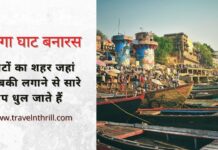
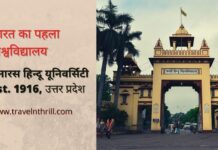
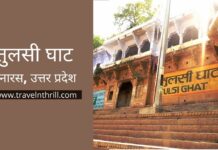
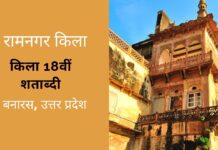
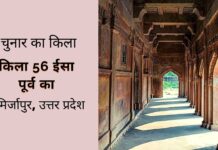









![Kamakhya Temple – A Mysterious Bleeding Goddess Complete Guide 2024 [Updated] kamakhya temple](https://travelnthrill.com/wp-content/uploads/2020/06/kamakhya-temple-100x70.jpg)